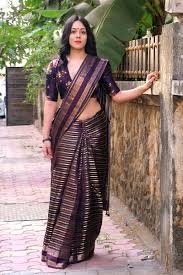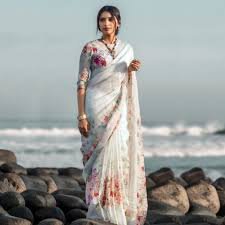They really are the real gem of Indian heritage and style, making women wonderful with their intricacy and flexibility. These traditional dresses come in the numerous kinds of materials, each with different characteristics and beauty. This manual contains a detailed study of the various types of saree fabrics, which is an entertaining format for those who wish to learn the creative and functional uses of these textiles that are so intricately crafted.

1. Silk Sarees
The silk sarees are actually the glamor and the poise in the parade. The shine and the softness they have become the features for which they are recognized. The most popular ones are:
- Banarasi Silk:
These sarees from the city of Banaras are mainly known for their zari work and offbeat images.
- Kanchipuram Silk:
Namely a product of Tamil Nadu, they are k,nown for their strong fiber and tones in colors.
- Mysore Silk:
These silk sarees from Karnataka are famous as they are very light and hence should be worn either on the daily basis or on a special occasion.

2. Cotton Sarees
Cotton sarees are the materials mostly preferred by women because of their comfort and breathability which in turn makes them the most suitable dress for warm weather. Some popular cotton saree materials are as follows:
- Bengal Cotton:
It is a matter of fact that Bengali women value not only the fineness of the fabric but also the traditional design of the saree that makes them a part of their wardrobes.
- Mangalagiri Cotton:
It’s a product of Andhra Pradesh and it is a plain fabric with simple geometric patterns which makes it very pretty.
- Chanderi Cotton:
A lot of people opt for lightweight yarn sarees that have a nice touch of silk in them. However, these are the ones that are made of cotton and silk collectively which are called Chanderi sarees.

3. Georgette Sarees
Those sarees are favorites because they are very light and at the same time they do not lack in having proper drape. They are made of twisted strands which have crumples naturally. These sarees are the favorites with customers because they are decorated with sequins, beads, or embroidery works, which are best suited for formal events.

4. Chiffon Sarees
Chiffon sarees have a light, translucent look and with their thinness and fluidity, they fall gracefully. Usually, they are decorated with cute little prints or fine embroidery making them proper not only for casual events but also for formal gatherings. Chiffon Sarees Wholesale in Coimbatore usually have a variety of chiffon sarees in a broad range of designs and colors.

5. Crepe Sarees
These sarees have a wrinkled, smooth texture and are very light allowing them to wrap very smoothly and are also available in plain and printed designs. Crepe sarees are all-rounder as they to be worn in the office as well as at parties.
Also Read : Guid to Build a Stone Birdbaths

6. Organza Sarees
Organza sarees are made from a very delicate yet glamorous looking fabric that gives them a unique look. They are usually adorned with beautiful embroidery or zari work, which is why they are very often picked for such extravagant events as weddings.

7. Linen Sarees
The popularity of linen sarees is increasing due to the eco-friendly nature of the fabric and their comfortable texture. Their look is slightly textured and they are known as the tough guys when it comes to the absorption of water, thus making them perfect for hot and humid weather conditions.

8. Synthetic Sarees
Sarees made out of synthetic materials, such as polyester and nylon, present a cheaper option than other types of clothes. They are also easy to maintain and come in all sorts of colors and prints. The example here is, in fact, the wide range of synthetic sarees offered by suppliers in Jaipur that are suitable for all tastes and financial capabilities.

9. Handloom Sarees
Handloom fabrics are made with the expertise of the weavers who are expertly trained and who practice the traditional technique. It commonly has its own unique visual presentation that depicts the culture of the region it came from – whether it be through patterns or textiles. Some popular handloom sarees are as follows:
- Pochampally Ikat:
Pochampally Ikat is a trademark Indian weaving pattern with broad lines running along the loom created by the ikat dyeing method.
- Jamdani:
This style usually employs intricate floral or geometric patterns woven into the fabric.
- Patola:
These are the double ikat sarees from Gujarat and are famous for their high intricacy of patterns and strong vibrant colors.
In addition to the various fabric types mentioned, it’s worth noting that different regions in India specialize in particular styles of sarees. Take the instance of Wholesale Sarees in Jaipur, which are famous for their flamboyant hues, as well as fine and complicated embroidery. Jaipur, renowned for being the Pink City, is a place where merchants trade old school Rajasthani fabrics and also exhibit a large palette of options of sarees that depict the likes of culture. Besides the more common designs, you are likely to find sarees with block print, bandhani (tie-dye), and gota patti work, which are mostly bought by saree collectors and fashion enthusiastic critics.
Conclusion
Saree fabric happens to be an extremely diverse and multitudinous area of the fashion industry, providing something unique for every taste, occasion, and budget. From the shiny silk that is the epitome of luxury to the moving cotton that is a comfort zone for women no fabric of them is alike. Whether you want a saree for regular wear or for a special event, knowing what the different fabric types are like can help you decide better. While the sari is still very much a part of the ever-changing fashion industry its timelessness and the great variety of fabric will surely keep it in the hearts of the generations to come.
